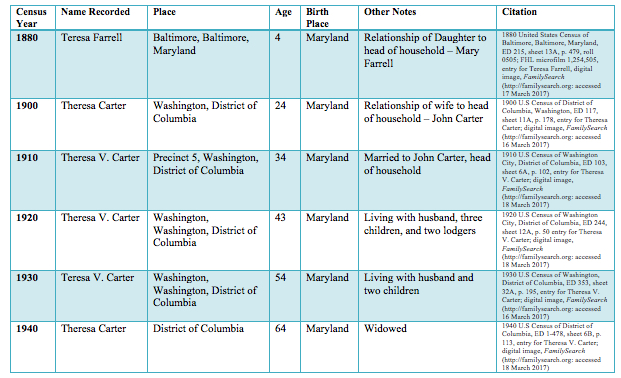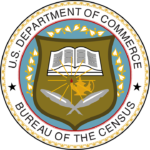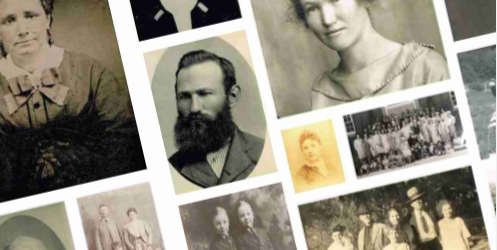Inside the Guide: Census Charts
Charts are tools that can be useful for a variety of different purposes, particularly in genealogical research. One situation where charts can help in your research is with a census survey. When conducting a census survey, it can be tricky to remember all the details about the individual you found from each census record, such as how old they were, where they were born, etc.
Remembering the information is vital. You need to correlate the information from one census record to another to determine if the people are the same. A census chart like the one shown below help you do exactly that.

Here are some tips on how to make an effective census chart when conducting a census survey for your ancestors.
-
- Census years. Start by adding to the census chart every census record your ancestor would
 have been found in throughout their lifetime. For example, Theresa Farrell was born in Maryland in 1876 and died in 1951, so she should be found on the 1880-1940 census records. Adding the years to your chart helps you keep track of the census records you should be able to find so that you don’t miss any.
have been found in throughout their lifetime. For example, Theresa Farrell was born in Maryland in 1876 and died in 1951, so she should be found on the 1880-1940 census records. Adding the years to your chart helps you keep track of the census records you should be able to find so that you don’t miss any. - Name recorded. Create a column for the name that was recorded on the census record for your ancestor. Sometimes the name your ancestor was listed under may not be consistent from census to census. For example, I’ve seen individuals who were listed under their first name on some census records and their middle name on others. It’s important to track the name your ancestor was listed under, so you can determine if there was a good reason the listing used that name, or if the individual listed is an entirely different person. Listing the name recorded can also be useful in conducting research for your female ancestors, to see when surnames changes after marriage.
- Place. Indicate the place where your ancestor was found on the census record. Comparing on each census record the places where your ancestor lived can help you track migrations and show where to look for other records. For example, Theresa Farrell was born in Maryland and lived there when she was four. Sometime before the age of twenty-four, she was married and had moved to Washington, District of Columbia. If I were to look for a marriage record between Theresa and John Carter, I would start by looking in Maryland or Washington, District of Columbia because those were the two places Theresa lived before and after her marriage.
- Age. Indicate the age your ancestor was, as listed on the census record. Although the ages listed on the census records were not always accurate, it helps to compare the ages on each census record to see if it would make sense for individuals to be the same person. For example, Teresa Farrell was four years old on the 1880 census record. Twenty years later on the 1900 census record, Theresa Carter was stated to be twenty-four years old. In this case, it would make sense that Teresa Farrell and Theresa Carter were the same people because of the consistency of her age between census records. Although comparing ages is useful, because of the possibility of age inaccuracy on the census record, age should not be used alone to correlate people between census records; it should be used only as a contributing factor.
- Birthplace. Mention the birthplace listed on the census record. Birthplaces are another category on the census that may not always be accurate. However, if the same birthplace is found on every census record for the same person, it may hold more weight than if a different place is listed on every census record. Listing the birthplace on your chart can also help serve as a starting point for your future research as you look for other records, such as birth records.
- Add other notes or categories. Examples of other notes could include other people in the household, the relationship to the head of household, the occupation, something that may be unusual about this census entry, etc. You may also choose to create separate columns for each of these categories.
- Include the citation. It is very important to include the citation to the census record, so that others can easily locate it in the future.
- Census years. Start by adding to the census chart every census record your ancestor would
In conclusion, census charts can help provide you with a visual reference as you analyze and correlate each census record to determine the life events of your ancestor.
For additional information on census research, visit the The Family History Guide, Countries, United States Research, Part C: U.S. Census Research.






Would be nice to have a form on this for Census research.
Do you have a blank form or link for me.